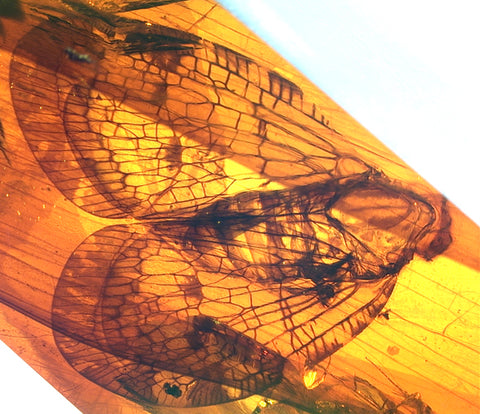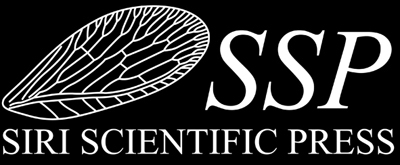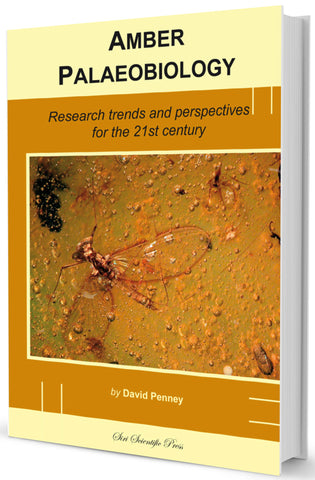New volume on fossil arthropods in Mexican amber
Posted by David Penney on
This is the second blog post in a series resulting from attending the 7th International Conference on Fossil Insects, Arthropods and Amber and concerns new fossils described from Mexican amber.

A fabulous fossil insect preserved in Miocene Mexican amber
At the meeting we met up with many of the world’s leading palaeoentomologists who have published their work with Siri Scientific Press. Without doubt the leading authority on fossils preserved in Mexican amber is Monica Solorzano-Kraemer from the Senckenberg Forschungsinstitut und Naturmuseum, Frankfurt, Germany. Monica wrote the chapter on Mexican amber in our Biodiversity of Fossils in Amber from the Major World Deposits, in which each chapter was written by a leading authority on the relevant deposit.
David Penney with Monican Solorzano-Kraemer and the volume on Biodiversity of Fossils in Amber from the Major World Deposits. CLICK HERE to read more about this title.
At the conference Monica spoke about her comparative palaeoecological comparisons of sticky trap, resin and amber from Mexican and Malagasy forests and also informed me of a new volume on Mexican amber inclusions which she had edited and which was published online throughout the duration of the meeting.
The volume consists of a preface and ten papers describing new fossils in Mexican amber. The following is taken from the preface written by Monica and her co-editor Francisco J. Vega:
“Mexican amber from the state of Chiapas is considered to be of Early Miocene age and derived mainly from the fossilized resin of the tree species Hymenaea mexicana (Angiospermae: Fabaceae). It is one of the most important amber resources from Central America. However, in comparison to the Dominican amber, the Mexican amber from Chiapas has been poorly studied.
The present volume presents not only systematic studies on fossil arthropods and plants from Simojovel and Totolapa amber (Chiapas, Mexico) but introduces also new collections that open the possibility to describe more material. All contributions provide new insights on the taxonomic diversity of Miocene arthropods, their morphological disparity and palaeoecology.
The reconstruction of the palaeoenvironment for this Mexican amber shows it was similar to modern lowland tropical forest, developed near the coast, in a mangrove palaeoenvironment. Some of the articles presented here discuss the relation of fossils with living arthropods from the region of Chiapas, and support the hypothesis that, at least part of this amber, is derived from a mangrove environment and that many elements of the modern Neotropical fauna originated and remain in place since the Early Miocene. Since the better-known Dominican Republic amber is also of Miocene age and derived from a Hymenaea species H. protera comparisons between similar species in Mexican and Dominican amber are also discussed in the present volume.”
The volume describes not only insects but also pseudoscorpions (Recent and fossil), flowers, crabs, a catalog from the Edinburgh collection, interesting discussions about the age, etc.
Scientists around the world are working on Mexican amber inclusions and the Museo de Paleontología "Eliseo Palacios Aguilera" is also happy to loan pieces of amber for more descriptions in the future.
From a personal perspective, I feel that Mexican amber is particularly important and accordingly included a section on it in my new book Amber Palaeobiology, which was released at the beginning of this month. Click the cover below for more information about this volume.
To give you an idea of my thoughts and a summary of recent work on this deposit, the following is taken from the above book:
“Despite amber mines in Chiapas being known since at least 250 B.C. (Solórzano Kraemer, 2007), Mexican amber has been little studied to date. However, new initiatives led primarily by Monica Solórzano Kraemer (but also independent studies by other researchers) are now rectifying this (e.g. Wichard et al., 2006; Solórzano Kraemer, 2007; Calvillo-Canadell et al., 2010; Edgecombe et al., 2012; Jennings et al., 2012; Ross & Engel, 2013; Strelow et al., 2013; Ibáñez-Bernal et al., 2013; Heinrichs et al., 2014, 2015; Engel, 2014; Scheben et al., 2014; Stebner & Solórzano Kraemer, 2014; Peris et al., 2015; Riquelme et al., 2015; Dunlop & Mrugalla, 2015; Dunlop et al., 2015a; Serrano-Sánchez et al., 2015; Drohojowska et al., 2016). Mexican amber is particularly important because it represents a continental deposit contemporaneous with the well-known insular deposits of the Dominican Republic. As noted by Penney (2008), the importance of Mexican amber derives from the fact that the Yucatan Peninsula did not have land connections to South America (post K/Pg and prior to the Mexican amber formation), whereas it would appear that Hispaniola did. Thus, any similarities of Mexican amber inclusions to the South American fauna must be a result of dispersal rather than vicariance of formerly connected populations. Thus, a comparative analysis of Mexican and Dominican amber taxa with proximate extant faunas will aid our understanding of the relative contributions of vicariance and dispersal for explaining the origins of current Caribbean biodiversity. Such comparisons can also be made with more distant geographical locations, as in the case of Peris et al. (2015), who compared Mexican and Dominican amber Platypodinae beetles with extant taxa from Madagascar, suggesting an Afrotropical origin for this element of the Neotropical beetle fauna, contemporaneous with the dispersal of the Hymenaea (the amber producing tree) lineage from the same region to the New World, as proposed by Poinar (1991).
Serrano-Sánchez et al. (2015) identified a new Miocene fossiliferous deposit from the Campo La Granja mine in Chiapas, which differs from other sources of amber in Mexico. Campo La Granja amber has distinct layers created by successive flows of resin with thin layers (<1–4 mm) of sand on most surfaces (probably the result of tidal influence, which would explain how repeated flows acquired sand grains on their surfaces prior to inundation by the next resin flow). The amber shows no evidence of significant post-depositional transport. Aquatic and semi-aquatic arthropods are common as inclusions, including a large number of ostracods (many with their carapaces open, suggesting that they were alive and submerged in water at the time of entombment) and examples of brachyuran crabs. Preliminary reports on the ostracods (more than 500 inclusions), amphipods (63 inclusions), terrestrial isopods (19 inclusions), crabs (<10 specimens) and aquatic insects were recently reported at scientific conferences by Serrano et al. (2007, 2014), Serrano & Vega (2014), Vega et al. (2009, 2010, 2011) and Hegna et al. (2010, 2013) [all the aforementioned citations are conference abstracts cited in Serrano-Sánchez et al., 2015], with more complete descriptions currently in preparation (Serrano-Sánchez et al., 2015).
Some mangrove regions located on the Pacific coast of southern Mexico have a floral composition, climate and geographic location very similar to the former Mexican amber forest. The extant forest of the Pacific coast of southern Mexico, in the state of Chiapas, in the biosphere reserve “La Encrucijada”, shows great similarity of floral composition with the former amber forest, characterised as a tropical lowland area close to mangroves. In this region, almost all of the living plants have also been identified from the palynological record of the amber bearing sediments, including the genus Hymenaea, which was the original resin producing tree for the Mexican and Dominican ambers, in addition to copal from many regions in South America (Solórzano Kraemer et al., 2015). Hence, these forests provide an excellent opportunity for comparing the diversity of extant and fossil faunas with the aim of learning more about bias of preservation in amber (Solórzano Kraemer & Stebner, 2012; Solórzano Kraemer et al., 2013ab, 2015 – discussed later).”
The new volume on Mexican amber edited by Monica Solorzano-Kraemer is open access. Clicking the volume cover in this blog post will take you to the page where the papers can be accessed. Happy reading … and congratulations to Monica for her continued efforts to promote the importance of this relatively understudied deposit!

Share this post
- 0 comment
- Tags: Conference, Events, New research, News
0 comment



